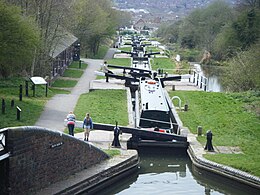Delph Locks

The flight from lock 2
|
|
| Waterway | Dudley Canal |
|---|---|
| Maintained by | Canal & River Trust |
| Operation | Manual |
| First built | 1799 |
| Length | 70 feet (21.3 m) |
| Width | 7 feet (2.1 m) |
| Fall | 85 feet (26 m) |
| Above sea level | top lock: 441 feet (134 m) |
| Flight of 8 locks | |
Delph Locks or the Delph Nine are a series of eight (originally nine) narrow canal locks on the Dudley No. 1 Canal in Brierley Hill, in the West Midlands, England. They were opened in 1779, and reopened in 1967 following restoration of the Dudley Canal and the Stourbridge Canal in a joint venture between the Staffordshire and Worcestershire Canal Society and the British Waterways Board.
The Dudley Canal and the Stourbridge Canal were originally planned as a single canal, for which a bill was submitted to Parliament in the spring of 1775. It was opposed by the Birmingham Canal Navigations, and so the project was split in two and resubmitted. Despite continued opposition by the Birmingham Canal, both canals were authorised by separate Acts of Parliament on 2 April 1776. The engineer Thomas Dadford was responsible for the construction of the Dudley Canal, which terminated at a flight of nine locks at its southern end. Construction was finished in June 1779, but the locks saw little use until the opening of the Stourbridge Canal, which took place in December. Dadford's son, also called Thomas, was engineer for the Stourbridge Canal. In 1787, discussions took place about amalgamating the two companies, but they remained separate, although they always worked closely together.
The bottom lock at Black Delph Bridge is at the termination of the Dudley Canal and forms the boundary with the Stourbridge Canal. The flight has distinctive waterfall overflow weirs, and rises from the 356-foot (109 m) Stourbridge level to the 441-foot (134 m) level of the Dudley No. 1 canal. The middle seven of the original 1779 locks were rebuilt in 1858 as six new locks, reducing the flight to eight. Some ruins of the old locks are visible to the side of the new.
...
Wikipedia
